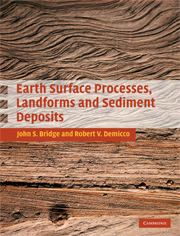Book contents
- Frontmatter
- Contents
- Acknowledgments
- Figure credits
- PART 1 Introduction
- PART 2 Production of sediment at the Earth's surface
- PART 3 Fundamentals of fluid flow, sediment transport, erosion, and deposition
- PART 4 Environments of erosion and deposition
- PART 5 Sediment into rock: diagenesis
- PART 6 Long-term, large-scale processes: mountains and sedimentary basins
- References
- Appendix: Methods of study of Earth surface processes, landforms, and sediments
- Index
- Plate section
Appendix: Methods of study of Earth surface processes, landforms, and sediments
Published online by Cambridge University Press: 05 June 2012
- Frontmatter
- Contents
- Acknowledgments
- Figure credits
- PART 1 Introduction
- PART 2 Production of sediment at the Earth's surface
- PART 3 Fundamentals of fluid flow, sediment transport, erosion, and deposition
- PART 4 Environments of erosion and deposition
- PART 5 Sediment into rock: diagenesis
- PART 6 Long-term, large-scale processes: mountains and sedimentary basins
- References
- Appendix: Methods of study of Earth surface processes, landforms, and sediments
- Index
- Plate section
Summary
APPENDIX 1: LANDFORMS, FLOW, AND SEDIMENTARY PROCESSES
Measurement of land-, water-, and icesurface topography
Land-surface topography
The topography of the subaerial and shallow-subaqueous land surface has traditionally been measured using standard surveying techniques (e.g., digital tacheometry: total stations) and using stereo aerial photographs. Some older readers may even remember topographic surveying with compasses, chains, plane tables, and alidades. Relatively accurate surveying of land topography is now accomplished with the global positioning system (GPS), with vertical and horizontal resolution of centimeters possible. Laser range finders are also now used for topographic mapping, and data from these can be tied into GPS data. Lidar (light detection and ranging) is the acronym used for a variety of surveying techniques using light beams directed at a target. Lidar can be done from the ground or from the air. Digital photogrammetry in combination with GISbased digital elevation models has also been developed for measuring subaerial topography, although these methods are not yet as accurate as those mentioned above (e.g., Lane et al., 1998, 2001).
- Type
- Chapter
- Information
- Earth Surface Processes, Landforms and Sediment Deposits , pp. 795 - 862Publisher: Cambridge University PressPrint publication year: 2008



